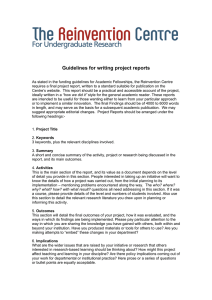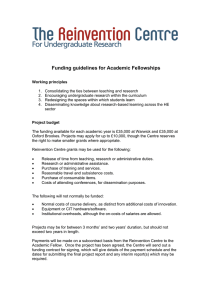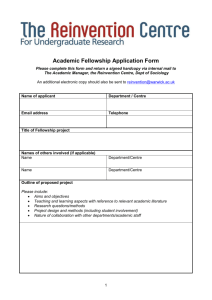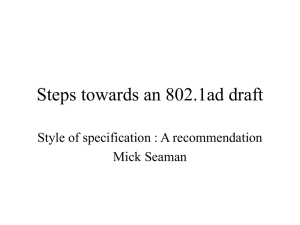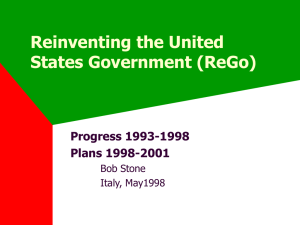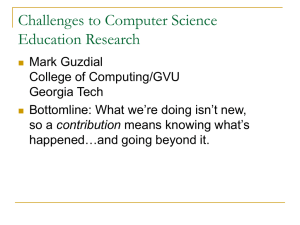Dissatisfaction Does Not Mean Rejection
advertisement
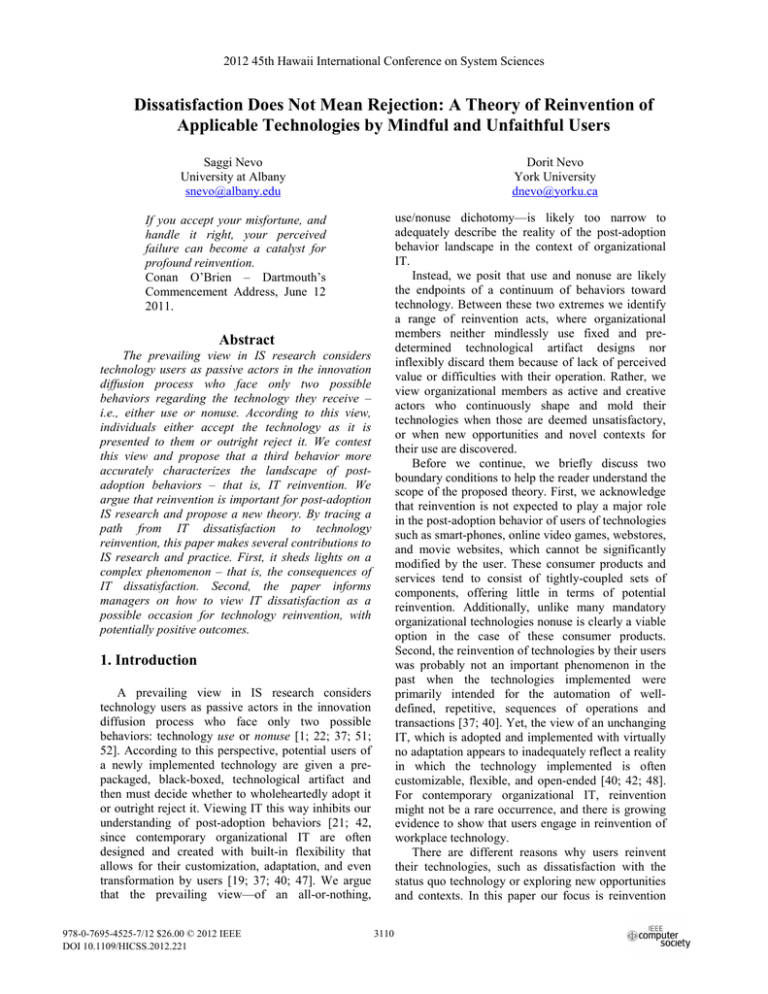
2012 45th Hawaii International Conference on System Sciences Dissatisfaction Does Not Mean Rejection: A Theory of Reinvention of Applicable Technologies by Mindful and Unfaithful Users Saggi Nevo University at Albany snevo@albany.edu Dorit Nevo York University dnevo@yorku.ca use/nonuse dichotomy—is likely too narrow to adequately describe the reality of the post-adoption behavior landscape in the context of organizational IT. Instead, we posit that use and nonuse are likely the endpoints of a continuum of behaviors toward technology. Between these two extremes we identify a range of reinvention acts, where organizational members neither mindlessly use fixed and predetermined technological artifact designs nor inflexibly discard them because of lack of perceived value or difficulties with their operation. Rather, we view organizational members as active and creative actors who continuously shape and mold their technologies when those are deemed unsatisfactory, or when new opportunities and novel contexts for their use are discovered. Before we continue, we briefly discuss two boundary conditions to help the reader understand the scope of the proposed theory. First, we acknowledge that reinvention is not expected to play a major role in the post-adoption behavior of users of technologies such as smart-phones, online video games, webstores, and movie websites, which cannot be significantly modified by the user. These consumer products and services tend to consist of tightly-coupled sets of components, offering little in terms of potential reinvention. Additionally, unlike many mandatory organizational technologies nonuse is clearly a viable option in the case of these consumer products. Second, the reinvention of technologies by their users was probably not an important phenomenon in the past when the technologies implemented were primarily intended for the automation of welldefined, repetitive, sequences of operations and transactions [37; 40]. Yet, the view of an unchanging IT, which is adopted and implemented with virtually no adaptation appears to inadequately reflect a reality in which the technology implemented is often customizable, flexible, and open-ended [40; 42; 48]. For contemporary organizational IT, reinvention might not be a rare occurrence, and there is growing evidence to show that users engage in reinvention of workplace technology. There are different reasons why users reinvent their technologies, such as dissatisfaction with the status quo technology or exploring new opportunities and contexts. In this paper our focus is reinvention If you accept your misfortune, and handle it right, your perceived failure can become a catalyst for profound reinvention. Conan O’Brien – Dartmouth’s Commencement Address, June 12 2011. Abstract The prevailing view in IS research considers technology users as passive actors in the innovation diffusion process who face only two possible behaviors regarding the technology they receive – i.e., either use or nonuse. According to this view, individuals either accept the technology as it is presented to them or outright reject it. We contest this view and propose that a third behavior more accurately characterizes the landscape of postadoption behaviors – that is, IT reinvention. We argue that reinvention is important for post-adoption IS research and propose a new theory. By tracing a path from IT dissatisfaction to technology reinvention, this paper makes several contributions to IS research and practice. First, it sheds lights on a complex phenomenon – that is, the consequences of IT dissatisfaction. Second, the paper informs managers on how to view IT dissatisfaction as a possible occasion for technology reinvention, with potentially positive outcomes. 1. Introduction A prevailing view in IS research considers technology users as passive actors in the innovation diffusion process who face only two possible behaviors: technology use or nonuse [1; 22; 37; 51; 52]. According to this perspective, potential users of a newly implemented technology are given a prepackaged, black-boxed, technological artifact and then must decide whether to wholeheartedly adopt it or outright reject it. Viewing IT this way inhibits our understanding of post-adoption behaviors [21; 42, since contemporary organizational IT are often designed and created with built-in flexibility that allows for their customization, adaptation, and even transformation by users [19; 37; 40; 47]. We argue that the prevailing view—of an all-or-nothing, 978-0-7695-4525-7/12 $26.00 © 2012 IEEE DOI 10.1109/HICSS.2012.221 3110 stemming from IT dissatisfaction, as we describe next. hospital and was designed for direct entry by physicians. According to the authors, the source of the “The physicians’ dissatisfaction… [was that] the machine could not keep up with [them].” As a result of this IT dissatisfaction, “the hospital appointed a nurse to enter data for them.” Orlikowski [39] discusses the implementation and use of an incident tracking support system (ITSS) within the customer service department (CSD) of a certain organization. According to the author, users’ (i.e., the CSD specialists’) dissatisfaction with the “navigation of ITSS’ structured data entry screen [that] was incompatible with how information was provided by customers,” resulted in the “Specialists’ practice of working around the direct electronic entry of calls.” Orlikowski refers to this “bypassing of direct entry” as a technological improvisation. Another example of reinvention as a result of dissatisfaction with IT is provided by Boudreau and Robey’s [8] study of an ERP implementation. In this case study, dissatisfied “users deviated from prescribed work processes, and ‘tweaked the system’ to make it respond to their needs. Through such tweaking (also called workarounds), users sought to circumvent the rigid work processes embedded into Compass’s software routines, thereby making the system work in ways that they could better understand and control. In some cases, users established workarounds to compensate for what they considered deficiencies within the system.” Also, in the same case study, the authors observe that “[a]lthough most users understood that this feature provided greater security, they felt that the feature limited their freedom. Many users devised ways to beat the system.” The authors then note that “These reinventions allowed users to… compensate for [the ERP’s] perceived limitations.” In sum, we envision dissatisfaction with organizational IT not necessarily as an unfortunate end-state of technological implementation or as an indication of a failed IT project, but rather, under certain conditions (discussed in subsequent sections), as an occasion for possible reinvention of the technology by its users. We elaborate on the notion of reinvention next. 2. IT Dissatisfaction Satisfaction with technology is considered an important indicator of technological innovation success since it is expected to foster positive attitudes toward the technology and lead to its continued use [5; 22; 31; 43; 45; 52; 59]. In a similar fashion we can link IT dissatisfaction with technology rejection, nonuse, and discontinuance [6; 31]. Such a view of satisfaction (or dissatisfaction) with IT and its consequences is consistent with its theoretical foundation – namely, consumer behavior research [38; 49]. Indeed, when viewed as a consumer, an individual who purchased, say a Webcam (or a monthly subscription to Netflix or a World of Warcraft for that matter), and who is satisfied, is likely to continue using it. On the other hand, the individual is also in a position to discontinue his use of the product or service if he becomes dissatisfied with it. However, we contend that IT dissatisfaction must not always lead to rejection of the technology by its users; least of all in the context of installed organizational IT. Primarily, organizational members may feel dissatisfied with a certain workplace technology but are forced to continue their use of it [8; 23]. That dissatisfaction with IT can lead to its reinvention by users is consistent with the more general notion that dissatisfaction with the status quo propels individuals to search for improved conditions [34]. This suggests that when the use of an organizational IT is compulsory, and therefore the technology cannot be discarded or its use discontinued [21], dissatisfied users might initiate a search for ways to improve the technology or develop new ways for using it. In fact, we go further and argue that even if individuals use a technology out of their own volition it is not obvious that users’ reaction to IT dissatisfaction would always be to discard the technology. Instead, if the adaptation and modification an installed IT are possible, dissatisfied users might search for ways to improve it even when nonuse is possible. Notwithstanding the possibility of reinvention of noncompulsory organizational IT, in this paper we focus on mandatory IT use, which we note is typical of many organizational settings [9; 23]. We resort to several examples to illustrate the notion that dissatisfaction with IT can lead to technology reinvention. Consider, for example, Lapointe and Rivard [28], where an electronic medical records technology was implemented in a 3. Reinvention Reinvention is defined as the degree to which an innovation is changed or modified by a user in the process of adoption and implementation after its original development, and may involve both the innovation as a tool and its use [46; 47; 48]. Building on Rogers et al., in the context of IT, reinvention can be measured as the degree to which an individual’s use of a new technology departs from the core or mainline version of the technology. The absence of reinvention indicates high fidelity between the 3111 technology’s intended use and design and its actual use [30]. In related literature, in the late 1980s, scholars such as Leonard-Barton [29] and Zuboff [60] recognized the possibility of technology adaptation and its potential benefits in the post-adoption phase. Later, DeSanctis and Poole enhanced our collective understanding of this phenomenon by developing adaptive structuration theory [16; 44]; and Orlikowski et al., in a series of case studies clearly described the process of adaptive structuration of new technologies by their users [39; 40; 41; 56]. More recent case studies, and a few quantitative studies, continue to support the notion that technologies do not remain static after their implementation and are often adapted by their users [22; 8; 19; 32; 37; 51]. Such adaptation is considered to have positive impact on the users and their organizations, including an improved fit between users and the technology and adapting to changes within the organization [2; 10; 21; 56]. These works suggest that technological artifacts reflect the more general innovation diffusion process in which adoption is not an all-or-nothing process. Instead, users are active agents of intra-organizational implementation and adoption [30]. According to this view, the choices available to a potential adopter are not just adoption or rejection; modification of the innovation or selective adoption (or judicious rejection) of some components of the innovation may also be options [46]. As such, users become part of the innovation process, where innovations that were constructed by designers are subsequently reconstructed by their users [7]. Therefore, an innovation is not a fixed entity, which enters a social system (e.g., an organization) from the environment and is then mindlessly adopted, but rather is adapted as it diffuses throughout a social system [48]. We subscribe to Rogers et al.’s assertion that reinvention exists, is not necessarily bad, and is a natural part of the innovation process [46; 47; 48]. Therefore, recognition of the existence of reinvention can bring into focus a different, and potentially more accurate, view of technology post-adoption behaviors. Wearing the lens of reinvention we recognize that within an organizational context, instead of simply accepting or rejecting a technological innovation, potential adopters are active participants in the adoption and diffusion process, and they generally think that reinvention is a good thing. Unfortunately, such a non-deterministic view of technology has not, for the most part, informed our models of technology post-adoption behaviors, and the notion of reinvention remains underexplored and underutilized [19]. Accordingly, potential users are still predominantly treated as passive actors in the diffusion process. When a less deterministic view is adopted it is primarily to reflect a change of perceptions [6; 24] or of frequency of use [31], but a more active role for users is yet to be acknowledged. Thus, our knowledge of post-adoption behaviors, especially those that conform neither to use-without-change nor to complete rejection, remains lacking. Throughout this paper, we refer to several published case studies to help describe the process of reinvention of organizational IT by their users. In this section we report on three different technologies, each implemented in a different organization. First. in Fedorowicz and Gogan [19], we learn about a public health interorganizational technology that was designed and implemented with the intension of serving as a tool for early detection of bio-terror attacks but, according to the authors, was later reinvented to serve a broader set of goals. Second, in Lapointe and Rivard [28], an electronic medical records technology was reinvented to modify the manner in which patient information was entered. Third, in Orlikowski and Hofman [40], an incident tracking support system (ITSS) was reinvented as a training tool: “As the number of incidents in ITSS grew, some senior specialists began to realize that they could use the information in the system to help train newcomers.” Also in the same case, “[users] incorporated enhancements to the ITSS system as they realized ways to improve ease of use and access time.” Based on their findings, the authors observe that the users “conceived of and implemented the changes in situ and in response to the opportunities and issues that arose as [they] gained experience and better understood the new technology and the particular use of it.” The third case might give the impression that reinvention is an indication of extended or enhanced use of the technology [21], however this is not always the case; for example, in Lapointe and Rivard, reinvention was a result of group of users’ (the physicians’) dissatisfaction with the focal technology. Another case study illustrating the notion that reinvention need not lead to feature extension is provided by Orlikowski [41]. In this case, a new IT was implemented in order to “address the considerable [redundancy] which occurred when Alpha consultants in different offices worked on similar client problems without sharing ideas, approaches, or solution.” However, once implemented, consultants’ “use of Notes was minimal, even perfunctory, and involved opening electronic mail folders a few times a week, rarely, if ever, sending a message, and only occasionally accessing a discussion database to examine activity in it… [They saw it as] countercultural and 3112 incompatible with their individual advancement and success in the firm.” It is interesting to note that within the same organization, a small group of consultants “saw [the IT] as an opportunity to enhance their own individual effectiveness by speeding up existing ways of doing things… [and] began to use Notes regularly to perform activities previously conducted on paper or with other media. Some also used Notes to obtain electronic newsfeeds... These consultants believed their use of Notes would give them a competitive edge in their firm by advancing their personal productivity… [They] engaged specific properties of Notes to enact a set of rules and resources which increased their work productivity and incrementally modified the technology.” Both groups of users (more precisely, subgroups of the consultant group) reinvented the technology, albeit in different ways; the technology was intended as a tool for knowledge sharing but was appropriated in manners not consistent with such view, to varying extents, and with different results. According to Lewis and Seibold, negative attitudes, lack of respect toward, and discomfort with the innovation will be strongly related to lack of fidelity in innovation use. We see an evidence of this in the larger subgroup of consultants in the Orlikowski’s case. For example, “some consultants had doubts about the value of Notes for their own and the firm’s performance. The skepticism felt by these consultants was exacerbated by their limited knowledge of Notes’ functionality. [Consultants felt that] the training sessions were technical and abstract… they found the training condescending and unhelpful… [They] remained skeptical and unmotivated.” It is therefore not surprising to find a low degree of fidelity in their use of the technology. The smaller group of consultants was also apparently not willing to use the technology for knowledge sharing, however their greater awareness of the technology’s capabilities propelled them to reinvent it in a different way. While Lewis and Seibold’s list of factors capable of inducing low fidelity appears quite sever, it seems that milder forms of dissatisfaction may suffice to induce technological reinvention. For example, consider the case study written by Majchrzak et al. [32]. The authors of that case describe the events following an implementation of a communication technology (CT) for the use of a virtual team; “During the course of the project, the CT itself was modified in significant ways. Some of this modification was in the addition of new features, some in the decision to not use certain features, and some in the intent to which features were used… Access privileges were initially set to allow both management and team members access to the tool and members were expected to use external application viewers to share their documents. Team members instead eventually limited access to only team members, deciding to exclude management. In addition, team members pushed the developer to create a screen capture feature, which eliminated the need for external application viewers… [Certain] features [were] mostly unused.” Another important change, “to couple virtually all use of the tool with a synchronous ‘meet-me’ telephone conference,” was a result of a realization that “While the members had agreed to try brainstorming technology asynchronously, over time, it became apparent that members were able to brainstorm virtually, but not asynchronously.” Drawing conclusions from her case study, Orlikowski [41] noted that “people are purposive, knowledgeable, adaptive, and inventive agents who engage with technology in a multiplicity of ways to accomplish various and dynamic ends… When the technology does not help them achieve those ends, they abandon it, or work around it, or change it, or think about changing their ends… Users will continue to modify their technologies and continue to change their uses of technology over time… Technologies are often not used as designed or intended.” When we add Lewis and Seibold’s observation that attitudes toward the technology and discomfort with its operation can lead to lack of fidelity – that is, reinvention – we propose that dissatisfaction with an IT can be a strong motivator for its reinvention. Accordingly, Proposition 1: Dissatisfaction with IT can result in the reinvention of the technology. In the following sections we discuss several factors upon which the reinvention of dissatisfactory organizational IT may be contingent. 4. Applicability Not all organizational IT are equally likely to be reinvented by their users, even when mild or strong negative attitudes towards them prevail. For example, you may not be able to reinvent Salesforce.com, using it other than in the way in which it was intended to be used. Similarly, Radio Frequency Identification (RFID) technology might exhibit a very limited usability repertoire, thereby restricting its usage to the goals prescribed by its designers. However, when organizational technologies are designed with an open architecture that is adaptable, programmable, and reconfigurable, their users can continuously customize existing features and create new applications [40; 41]. Indeed, as observed by 3113 Swanson [53], certain technologies – i.e., those that can be enhanced and extended – are more likely to be adapted and modified than others. Many organizational IT seem to fit this profile, making them likely candidates for reinvention [19]. DeSanctis and Poole [16] observed that most technologies are really sets of loosely-bundled capabilities and can be implemented in many different ways, with a variety of possible combinations of features. They added that “The more comprehensive the system, the greater the number and variety of features offered to users.” Recently, Fedorowicz and Gogan [19] concluded that the case’s focal technology’s flexible foundation enabled its subsequent reinvention by users. Thus, it appears that the extent of reinvention is likely to be greater with unrestrictive and comprehensive technologies since these properties allow for many possible applications. For example, Orlikowski [39] observed that “Had a more rigid, more fixed-function technology been used, the pattern of use and change realized within the customer service department would have been different.” Similarly, DeSanctis and Poole [16] noted that “The more restrictive the technology, the more limited is the set of possible actions the user can take.” On the other hand, as observed by Rice and Rogers [46], technologies that are comprised of loosely-coupled sets of components make it possible for users to partially adopt them, keeping and using some components while rejecting others. Thus, when technologies have a high degree of flexibility (that is, unrestrictiveness and comprehensiveness), they can be readily changed to better meet emerging needs and new situations, thus encouraging users to customize them and allowing them to reinvent them by creating new capabilities [47; 48]. In sum, the less restrictive the technology is and the more comprehensive it is in terms of the number and variety of features, the greater the repertoire of actions its exposes to its users. DeSanctis and Poole argued that lengthy feature lists are not ideal when studying appropriation of technologies and suggested that those be replaced with more parsimonious attributes. They proposed that such attributes may be found by scrutinizing what users are able to do with their technologies. Dearing and Meyer’s [13] notion of applicability, which is an indication of the degree to which an innovation has more than one use or can be used in more than one context appears to provide a more holistic view of the extent to which a technology can be reinvented. Accordingly, we adopt Dearing and Meyer’s notion of applicability and adapt it slightly for the purpose of this paper. As a result, we define applicable technologies as technologies that can be used in multiple ways and/or contexts. When we assess IT with regard to their applicability, we can infer that the extent of technology reinvention as a result of IT dissatisfaction may be greater when the technology itself is highly applicable. Such an amplifying effect is expected since in the absence of applicability, which reflects architectural and operational restrictiveness and limited functionality, dissatisfied users would be constrained in terms of how they use the technology and for which purposes they can apply it [32; 39]. Accordingly, we advance the following proposition: Proposition 2: Users who are dissatisfied with highly applicable IT are more likely to reinvent them (or reinvent them to a greater extent) compared with dissatisfied users of less applicable IT. 5. Unfaithfulness Some researchers suggested measuring reinvention as the degree to which an individual’s use of a new technology departs from the core or mainline version of the technology as promoted by a change agency [48]. Orlikowski [41] observed that, “users in their recurrent interaction with technologies may always choose to depart from designers’ a priori intentions and the inscribed properties of the technology.” Lewis and Seibold [30] defined lack of fidelity (that is, reinvention) as the gap between the technology’s intended use and design and its actual use. Building on these scholars, we suggest that in order to assess reinvention as a post-adoption behavior we need to address the technology’s original intent and purpose, perhaps as it was communicated to potential adopters by those introducing the technology. The spirit of the technology, which is the general intent regarding the technology’s values and goals as prescribed by its designers and implementers and is associated with a set of features [16; 17; 32; 35; 44], appears to reflect what Rogers and Lewis and Seibold consider the official or mainline version of the innovation. The spirit of a technology can be inferred from its design metaphor (e.g., knowledge sharing system or customer relationship management system); the labeling of its most salient features, during training sessions in which proper and improper uses are highlighted; through official announcements, and; by communicating a new performance criteria [15; 16]. For example, Dennis et al. note that formal training may be used to “dissuade unfaithful appropriation acts and encourage faithful appropriation… Appropriation training educated 3114 members about the structures and how to use them.” They also note that establishing restrictions is used to constrain users and make it more difficult to adopt structures in ways unfaithful. As such, spirit is seen as capable of instructing users how to legitimately act upon the technology in a certain context. Several of the case studies used throughout the paper note that the technology’s spirit was made known to users. For example, “[the technology] was deliberately designed to enable users to record, chronologically, the work being done on each incident, as it was being done [39].” And, “one of the stated purposes of acquiring an ERP package: to foster paperless office [8].” Finally, “[users] initially accepted appropriations that deferred to the technology’s spirit [32].” While the features of the technology are intended to advance the technology’s spirit but are independent of it, indicating that the former may be appropriated in a manner that is unfaithful to the latter [16]. Even though unfaithful appropriation is not officially labeled “bad,” it is nonetheless expected that faithful appropriation would lead to better outcomes [3; 9; 15; 16; 36; 55]. And while Leonard-Barton [29] suggested that, at least in the early stages, unfaithfulness is less of a concern than misalignment between the task and the technology, and Fuller and Dennis [20] found that when tasktechnology fit is low unfaithful appropriation can bring about positive results, the prevailing view considers unfaithful appropriation to be an undesirable behavior. This view may be due to change agencies’ general tendency to believe that they know better than others, or perhaps because it is difficult to measure the diffusion and impact of an innovation which does not remain faithful to its mainline version [46; 48]. While unfaithful appropriations are not common in IS research, they appear to be common in IS practice [10; 12; 16; 19; 30; 53]. Building on the concepts of spirit and faithful appropriation we conceptualize faithfulness as an indication of a user’s intention to employ the technology in a manner consistent with its mainline or core version of the technology. Unfaithfulness is therefore a behavioral intention that veers away from the spirit of the technology. Treating faithfulness (or unfaithfulness) as a behavioral intention helps us connect IT dissatisfaction, which is an attitudinal construct [18], with reinvention, which is a post-adoption behavior [19; 21; 31]. We propose that IT dissatisfaction may be an important factor in inducing lower levels of faithfulness to the technology. Consider for example the cases reported by Boudreau and Robey [8] and Orlikowski [41]. In both case studies, users who did not want the new technology chose not to participate in formal training sessions, thereby remaining unaware to the technology’s spirit [15]. Not being fully aware of the intentions of the designers and implementers made the spirit less coherent [16], in turn making it easier for dissatisfied users to exhibit unfaithfulness toward the spirit. In addition, lack of training may have also reduced the level of comfort the users felt, which is expected to reduce fidelity [30]. Unfaithfulness may in fact develop even when the spirit is coherent and when users are initially faithful to it. For example, Majchrzak et al. [32] notes that “[users] initially accepted appropriations that deferred to the technology’s spirit.” However, subsequently, users decided to not use certain features and modify the intent to which other features were used, when they were “confronted with discrepant events that indicated that they could not leave the technology’s spirit intact if their performance goals were to be achieved.” Accordingly, we suggest that when users are dissatisfied with the technologies they use, they are less likely to remain faithful to their spirit since the latter is prone to be recognized as contributing to their dissatisfaction. Accordingly, and considering unfaithfulness’s role as behavioral intention, we propose the following: Proposition 3: Dissatisfaction with IT is likely to reduce faithfulness to the spirit of the technology. And, Proposition 4: Users who are less faithful to the spirit of the technology are more likely to reinvent it than faithful users. 6. Mindfulness So far, we have proposed that IT dissatisfaction can cause users to feel less faithful to the spirit of the technology, thereby increasing the chances that such users would engage in technology reinvention. We further argued that the extent of reinvention is likely to be greater when the technology itself is applicable and can be used for different purposes and in diverse contexts. We now introduce our final variable, mindfulness, which we expect to have an enhancing effect on reinvention. Mindfulness is defined as a state of mind where the individual is experiencing awareness to novelty, alertness to distinction, sensitivity to different contexts, awareness of multiple perspectives, and orientation in the present; the absence of these qualities characterizes a mindless state of mind [25; 3115 26; 27]. Mindful individuals are able to change their perspective to reflect the situation at hand [25; 26]. Alertness to distinction involves an ability to compare, contrast, and make judgments about how things are the same or different. Awareness of multiple perspectives allows individuals to see things from different points of view. Orientation in the present prompts individuals to devote more of their attention to their immediate situation. Individuals who are sensitive to context are aware of the characteristics of whatever particular situation they faces [10]. People who are mindful can reason with relatively novel kinds of stimuli, are comfortable adopting unconventional ways of thinking, think differently in dissimilar contexts, can think dialectically, and pay attention to their present surroundings [50]. Being mindful means ongoing analysis of existing expectations, alertness to any gaps between those expectations and actuality within a context, and willingness and ability to adapt expectations to reflect new experiences [58]. In sum, transitioning to mindfulness is likely an precursor to being able to notice when situations change (e.g., when gaps between expectations and actuality emerge) and take appropriate action [10; 54]. In contrast, mindlessness is the absence of the abovementioned properties. A mindless individual will not pay attention to contextual and organizational specifics, and will not spend efforts identifying and exploring new IT innovations. Such insensitivity and inattention to context and local specific is likely to cause a mindless technology user to overlook mismatches between the IT and the task, and in turn to fail to take corrective action [54]. Routine and habit are seen as possible indications of mindlessness, which may arise from premature commitment to beliefs that may not accurately reflect reality [10]. Mindlessness may cause individuals to lose their ability to critically evaluate, explain, and adapt their behavior, suggesting that IT dissatisfaction may not occasion reinvention acts. Returning to mindfulness, this state of mind is associated with openness to adaptation and improvisation, readiness for experimentation, and willingness to understand and learn from mistakes [10; 54]. This suggests that a mindful individual will not overlook gaps and problems but instead pay attention and then act if the current state (as opposed to the expected state) of the technology is deemed unsatisfactory. Such acts may involve creating innovative solutions to problems and/or modification of behaviors. Thus, a mindful individual is more likely to apply a technology in new ways and in different contexts [10; 25]. Accordingly, it appears that a mindful technology user is (1) more likely to be aware of his own IT dissatisfaction, which might result from gaps between expectations and actuality, and (2) take action to remedy the situation (e.g., by trying to use it differently). Accordingly, we propose the following: Proposition 5: Mindful individuals are more likely to act upon their dissatisfaction with IT by reinventing their technologies. Mindfulness may also encourage unfaithfulness to the spirit. To see this note that mindful technology users attend to innovations with reasoning grounded in contextual and organizational facts and specifics, and as such are expected to resist simplified, onesize-fits-all solutions that may be encoded in the spirit [10; 54]. Furthermore, mindfulness is associated with the ability to entertain complex and possibly conflicting interpretations, apply diverging perspectives, and think dialectically [26; 54; 58]. Such mindful individuals are less prone to blind faithfulness to the spirit as it prescribed by its designers and implementers. Accordingly, Proposition 6: Mindful individuals are less disposed to faithfulness to the spirit of an unsatisfactory IT. 7. Summary The prevailing view in IS research labels individuals as either users or nonusers of technology, treating them as passive recipients of an externally developed artifact. According to this view, individuals either wholeheartedly accept a technological innovation, habitually using it without change or they stop using it. Since IT satisfaction is considered a key antecedent of a technology’s continued use, then by extension, IT dissatisfaction is considered a powerful indicator of technology nonuse. This paper challenges this view—of an allor-nothing, use/nonuse dichotomy—and proposes instead that a third technology behavior more accurately characterizes the technology behavior landscape – namely, technology reinvention. Thus, the paper argues that dissatisfied users of technology, rather than reject installed organizational IT, are likely to reinvent it. This is particularly the case if the IT in question is highly applicable. The paper also proposes that the path from IT dissatisfaction to technology reinvention might not be a direct one but, rather, involve generating feelings of unfaithfulness toward the technology’s spirit, as prescribed by its designers and implementers. Finally, the paper suggests that mindful individuals are more likely than their mindless counterparts to acknowledge their IT 3116 dissatisfaction and act upon it by engaging in reinvention acts. This paper contributes to IS research, primarily to the adoption and diffusion streams, by treating dissatisfaction with IT as occasion for innovation. As such, it opens new avenues for IS research by (1) laying the foundations for additional theoretical development including searching for boundary conditions and identifying mediating and moderating variables, including firm-level variables and (2) inviting empirical examinations of the relationships proposed in this paper. [10] Butler, B. S. & Gray, P. H. 2006. Reliability, mindfulness, and information systems. MIS Quarterly, 30(2), 211-224. [11] Ciborra, C. U. 1992. From thinking to tinkering: The grassroots of strategic information systems. The Information Society, 8, 297-309. [12] Cooper, R. B. and Zmud, R. W. 1990. Information Technology Implementation Research: A technological diffusion approach. Management Science 36(2) 123-139. [13] Dearing. J. W. & Meyer, G. 1994. An exploratory tool for predicting adoption decisions. Science Communication, 16(1), 43-57. 8. References [1] Agarwal, R. and Prasad, J. 1997. The Role of Innovations Characteristics and Perceived Voluntariness in the Acceptance of Information Technologies. Decision Sciences 28(3): 557-582. [14] DeLone, W. H. & McLean, E. R. 1992. Information systems success: The quest for the dependent variable. Information Systems Research, 3(1), 60-95. [15] Dennis, A., Wixom, B. H., & Vandernberg, R. J. 2001. Understanding fit and appropriation effects in group support systems via meta-analysis. MIS Quarterly, 25(2), 167-193. [2] Ahuja, M. K. and Thatcher, J.B. 2005. Moving Beyond Intentions and Toward the Theory of Trying: Effects of Work Environment and Gender on PostAdoption Information Technology Use. MIS Quarterly 29(3): 427-459. [16] DeSanctis, G. & Poole, S. M. (1994). Capturing the complexity in advanced technology use: Adaptive structuration theory. Organizations Science, 5(2), 121-147. [3] M. Alavi, G. M. Marakas, Y. Yoo. 2002. A comparative study of distributed learning environments on learning outcomes. Information Systems Research 13(4) 404-417. [17] G. DeSanctis, M. S. Poole, I. Zigurs, G. DeSharnais, et al. 2008. The Minnesota GDSS Research Project: Group Support Systems, Group Processes, and Outcomes. Journal of the Association for Information Systems. 9(10/11) 551-608. [4] Bharadwaj, A. S. 2000. An organizational resource-based perspective on information technology capability and firm performance: an empirical investigation. MIS Quarterly 24(1) 169-196. [18] S. Devaraj, M. Fan, and R. Kohli. 2002. Antecedents of b2C channel satisfaction and preference: Validation e-Commerce metrics. Information Systems Research 13(3) 316-334. [5] Bhattacherjee, A. 2001 Understanding Information Systems Continuance: An Expectation Confirmation Model. MIS Quarterly 25(3) 351-370. [19] Fedorowicz, J. & Gogan, J. L. 2010. Reinvention of interorganizational systems: A case analysis of the diffusion of a bio-terror surveillance system. Information Systems Frontiers, 12, 81-95. [6] Bhattacherjee, A. & Premkumar, G. 2004. Understanding changes in belief and attitude toward information technology usage: A theoretical model and longitudinal test. MIS Quarterly, 28(2), 229-254. [20] Fuller, R. M. and A. R. Dennis. 2009. Does fit matter? The impact of task-technology fit and appropriation on team performance in repeated tasks. Information Systems Research 20(1) 2-17. [7] Boczkowski, P. J. 1999. Mutual shaping of users and technology in a national virtual community. Journal of Communication 49(2) 253-268. [8] Boudreau, M.-C. and D. Robey. 2005. Enacting Integrated Information Technology: A Human Agency Perspective. Organization Science 16(1) 3-18. [21] Jasperson, J., Carter, P.E., and Zmud, R.W. 2005. A Comprehensive Conceptualization of Post-Adoptive Behaviors Associated with Information Technology Enabled Work Systems. MIS Quarterly 29(3): 525-557. [9] S. A. Brown, A. P. Massey, M. M. MontoyaWeiss, and J. R. Burkman. 2002. Do I really have to? User acceptance of mandated technology. European Journal of Information Systems 11(4) 283-295. [22] J. Karimi, T. M. Somers, and Y. P. Gupta. 2004. Impact of Environmental Uncertainty and Task Characteristics on User Satisfaction with Data. Information Systems Research 15(2) pp. 175-193. 3117 [23] J. J. Po-An Hsieh, W. Wang. 2007. Explaining employees' Extended Use of complex information systems. European Journal of Information Systems 16(3) 216-227. [37] Nambisan, S., R. Agarwal, and M. Tanniru. 1999. Organizational mechanisms for enhancing user innovation in information technology. MIS Quarterly 23(3) 365-395. [24] Kim, S. S., and Malhotra, N. K. 2005. A Longitudinal Model of Continued IS Use: An Integrative View of Four Mechanisms Underlying Postadoption Phenomena, Management Science, 51(5): 741-755. [38] R. L. Oliver. 1999. Whence consumer loyalty? Journal of Marketing 63 33-44. [39] W. J. Orlikowski. 1996. Improvising organizational transformation over time: A situated change perspective. Information Systems Research 7(1) 63-91. [25] Langer, M. J. 1989. Mindfulness. Reading, MA: Addison-Wesley. [40] Orlikowski, W. J. and J. D. Hofman. 1997. An Improvisational Model for Change Management: The Case of Groupware Technologies. Sloan Management Review 38(2) 11-21. [26] Langer, E. J. 1997. The Power of Mindful Learning. Reading, MA: Addison-Wesley. [27] Langer, E. J. and Moldoveanu, M. 2000. The construct of mindfulness. Journal of Social Issues 56(1) 19. [41] Orlikowski, W. J. 2000. Using Technology and Constituting Structures: A Practice Lens for Studying Technology in Organizations, Organization Science, 11(4): 404-428. [28] Lapointe, L. and Rivard, S. 2005. A Multilevel Model of Resistance to Information Technology Implementation. MIS Quarterly 29(3) 461-491. [42] Orlikowski, W. J. and Iacono, C. S. 2001. Desperately seeking “IT” in IT research: A call to theorizing the IT artifact. Information Systems Research 12(2) 121-134. [29] Leonard-Barton, D. 1988. Implementation as mutual adaptation of technology and organization. Research Policy, 17(5), 251-267. [43] Petter, S., Delone, W., Mclean, E. (2008). Measuring information systems success: Models, dimensions, measures, and interrelationships. European Journal of Information Systems 17(3) 236-263. [30] Lewis, L. K. & Seibold, D. R. 1993. Innovation modification during intraorganizational adoption. Academy of Management Review, 18(2), 322-354. [31] Limayem, M., Hirt, S. G., and Cheung, C. M. K. (2007). How habit the predictive power of intention: The case of information systems continuance. MIS Quarterly, 31(4), 705-737. [44] Poole, M. S. and DeSanctis, G. 1990. Understanding the use of group decision support systems. In J. Fulk abd C. Steinfeld (Eds.), Organizations and Communication Technology, Beverly Hills, CA: Sage, 173193. [32] Majchrzak, A., Rice, R. E., Malhotra, A., & King, N. 2000. Technology adoption: The case of a computer-supported inter-organizational virtual team. MIS Quarterly, 24(4), 569-600. [45] A. Rai, S. S. Lang, R. B. Welker. 2002. Assessing the validity of IS success models: An empirical test and theoretical analysis. Information Systems Research 13(1) 50-71. [33] Malone, T., Lai, K. Y., and Fry, C. 1992. Experiments with OVAL: A radically tailorable tool for cooperative work. Proceedings of the Conference on Computer Supported Cooperative Work. ACM/SIGCHI & SIGOIS, Toronto, Canada 289-297. [46] Rice, R. E. and Rogers, E. M. 1980. Reinvention in the innovation process. Knowledge: Creation, Diffusion, Utilization 1(4) 499-514. [34] March, J. G. and Simon, H. 1993. Organizations (2nd Ed.), Blackwell, Oxford, UK. Rogers, E. M. and Allbritton, M. M. 1995. [47] Interactive communication technologies in business organizations. The Journal of Business Communication 32(2) 177-195. [35] M. L. Markus and M. S. Silver. 2008. A foundation for the study of IT effects: A new look at DeSanctis and Poole’s concepts of structural features and spirit. Journal of the Association for Information Systems 9(10/11) pp. 609-632. [48] Rogers, E. (2003) Diffusion of Innovations (5th Ed.). Free Press. New York NY. [49] Spreng, R. A., MacKenzie, S. B., Olshavsky, R. W. 1996. A reexamination of the determinants of consumer satisfaction. Journal of Marketing 60(3) 15-32. [36] S. M. Miranda, R. P. Bostrom. 1999. Meeting facilitation: Process versus content interventions. Journal of Management Information Systems 15(4) 89-114. [50] Sternberg, R. J. Images of mindfulness. 2000. Journal of Social Issues 56(1) 11-26. 3118 [51] Sun, H. Forthcoming. Understanding User Revisions When Using Information Systems Features: Adaptive System Use and Triggers. MIS Quarterly. [52] Susarla, A., A. Barua, & Whinston A. B. 2003. Understanding the Service Component of Application Service Provision: An Empirical Analysis of Satisfaction with ASP Services, MIS Quarterly, (27) 1: 91-123. [53] E. B. Swanson. 1994. Information Systems Innovation Among Organizations. Management Science 40(9) pp. 1069-1092. [54] E. B. Swanson and N. C. Ramiller. 2004. Innovating mindfully with information technology. MIS Quarterly 28(4) 553-583. [55] Thomas, D. M. and R. P. Bostrom. 2010. Vital signs for virtual teams: An empirically developed trigger model for technology adaptation interventions. MIS Quarterly 34(1) 115-142. [56] Tyre, M. J. and W. J Orlikowski. 1994. Windows of opportunity: Temporal patterns of technological adaptation in organizations. Organization Science 5(1) 98118. [57] Venkatesh, V., Morris, M. G., G. B. Davis, and Davis, F. D. 2003. Use acceptance of information technology: Toward a unified view. MIS Quarterly 27(3) 425-478. [58] Weick, L. E. and Sutcliffe, K. M. 2001. Managing the unexpected: Assuring high performance in an age of complexity, Jossey-Bass, San Francisco. [59] Wixom, B. H. and Todd, P. A. 2005. A Theoretical Integration of User Satisfaction and Technology Acceptance. Information Systems Research 16(1): 85-102. [60] Zuboff, S. 1988. In the Age of the Smart Machine. Basic Books, New York. 3119
